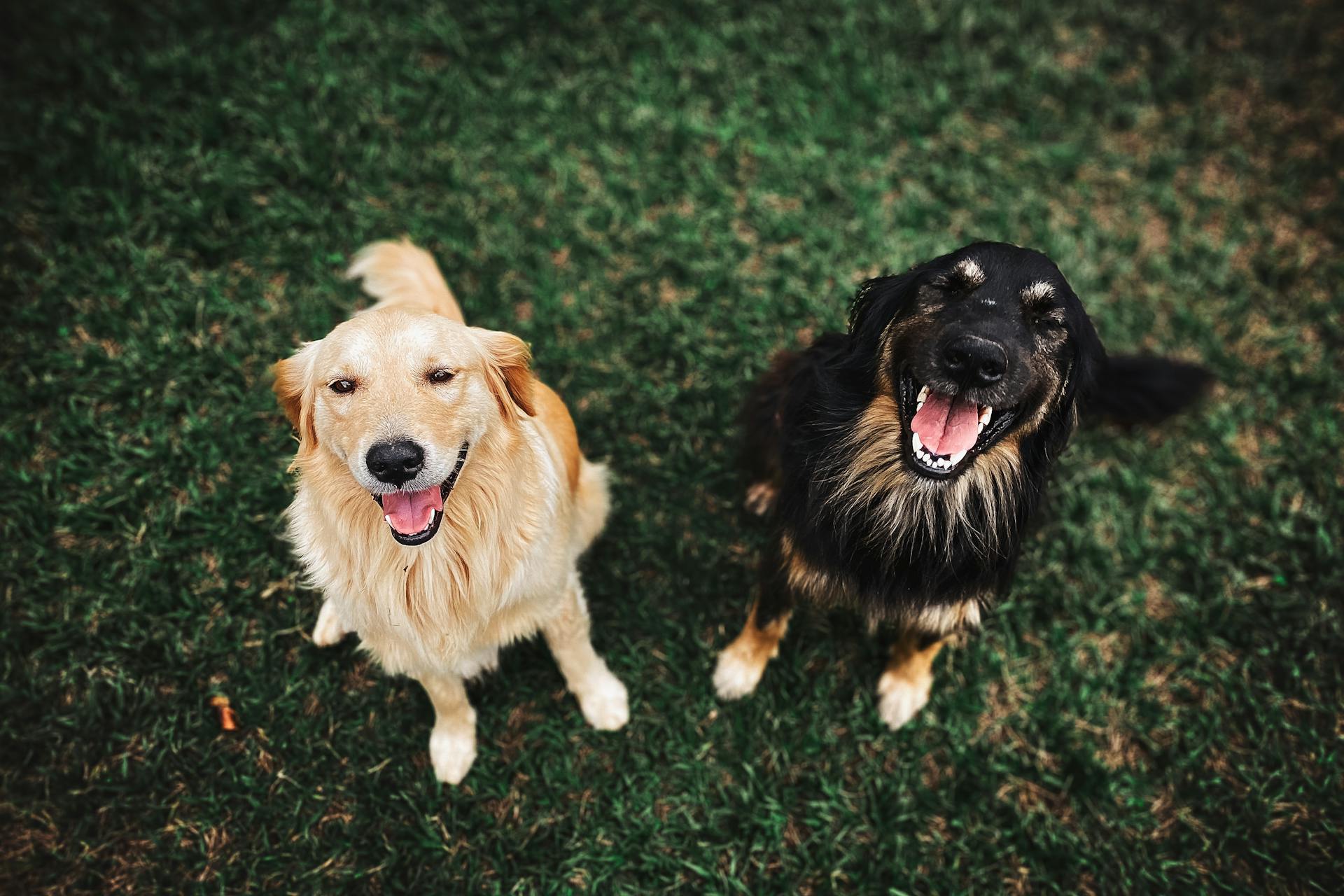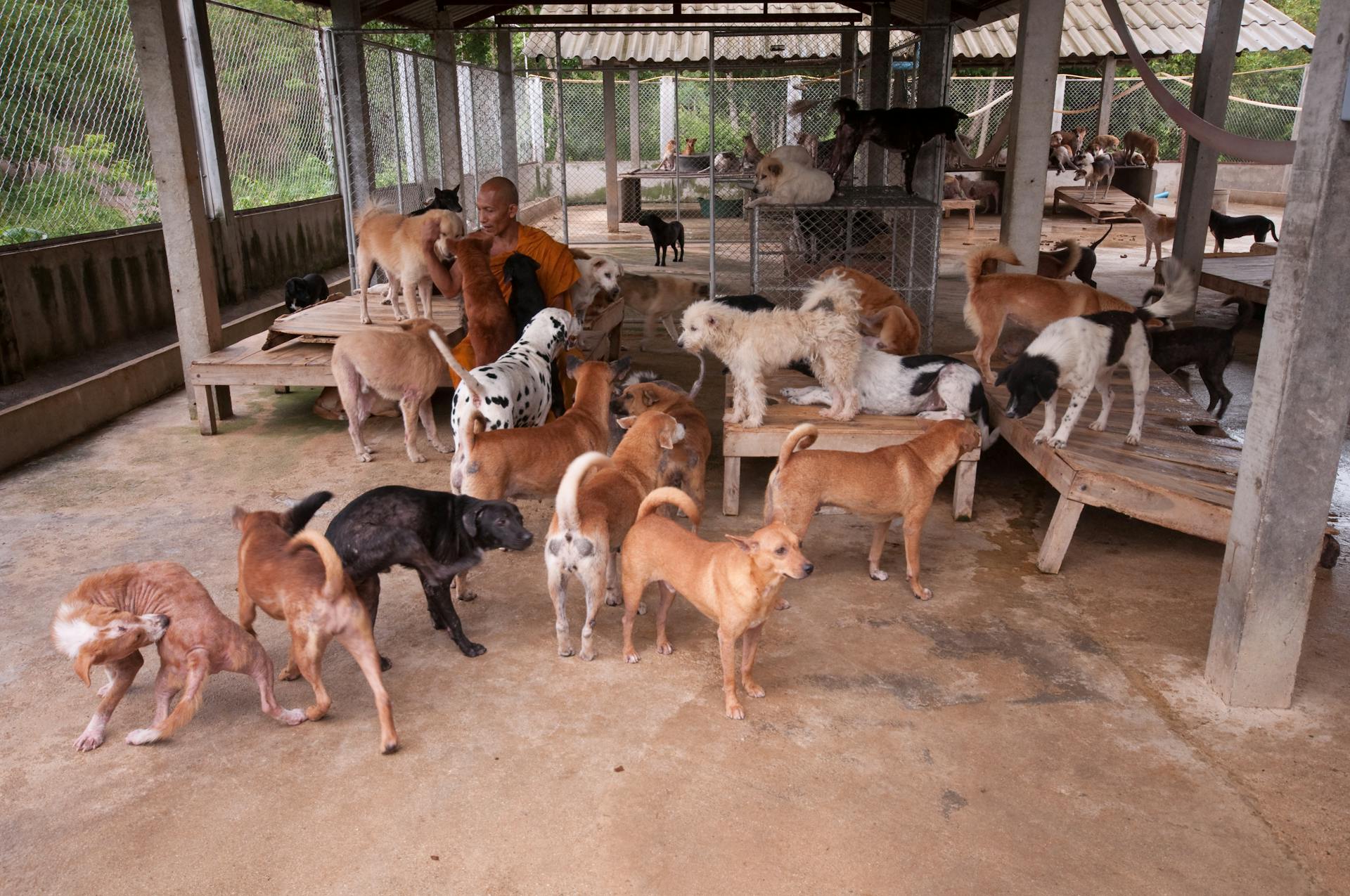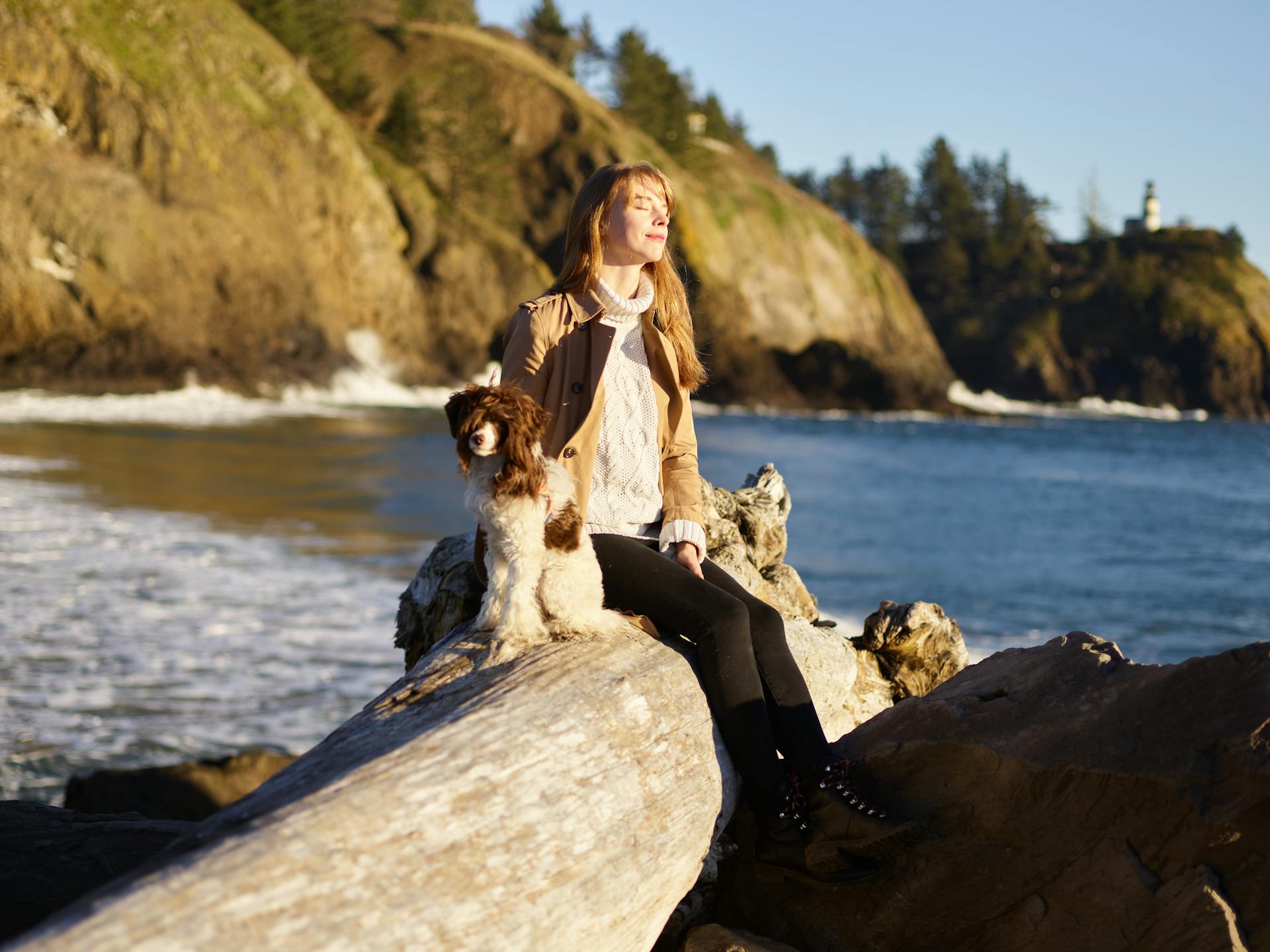
Dogs have been bred for thousands of years, with evidence of dog domestication dating back to around 15,000 years ago.
The process of creating new dog breeds is called artificial selection, where humans choose which traits to emphasize in breeding dogs. This selective breeding has led to over 340 recognized breeds today.
Human needs and preferences have driven the development of different breeds, such as herding dogs for farm work and companion dogs for social purposes.
Dogs by Breed
Dogs can be broadly categorized into dog types, which are broad categories based on form, function, or style of work, lineage, or appearance. These categories are quite different from modern dog breeds, which are specific breed standards determined by kennel clubs.
A study in 2010 looked at 48,000 single nucleotide polymorphisms in 912 dogs representing 85 breeds and found distinct genetic clusters within modern dogs that largely corresponded to phenotype or function. These clusters included spitz-breeds, toy dogs, spaniels, Mastiff-like breeds, small terriers, retrievers, herding dogs, scent-hounds, and sight-hounds.
Some breeds, like the Basenji, Saluki, Afghan hound, Samoyed, and Chow Chow, are genetically divergent from modern breeds and are thought to be the result of ancient breeding practices. These breeds include the Basenji, which is a unique breed with a distinct genetic profile.
Akita
The Akita is a muscular dog.
Their coat is double-layered, which helps them stay warm in cold climates.
I've always been impressed by their dignity, it's a trait that's hard to find in many breeds.
The Akita's ancient Japanese lineage is a testament to their rich history and cultural significance.
They're known for being loyal and protective of their families, which makes them great companions.
Their size can be intimidating, but they're also gentle giants, especially with those they trust.
American
The American breed of dog is definitely one to consider if you're looking for a strong and athletic companion. American Bulldogs, for example, demonstrate great strength and endurance.
Their athletic build is quite impressive, and they're well-balanced dogs that can keep up with an active lifestyle. American Bulldogs are a great example of this, with their ability to perform physically demanding tasks.
One of the most notable characteristics of American Bulldogs is their strength, which is likely due to their athletic build.
American Eskimo
The American Eskimo Dog is a breed that combines striking good looks with a quick and clever mind.
They are known for their white coats, which can be a single color or have a slight cream tint.
American Foxhound
The American Foxhound is a low-maintenance breed that gets on well with kids and other dogs.
They're known for being good-natured, which makes them a great addition to families with children.
One of the reasons American Foxhounds are so laid-back is because they're not high-strung or easily excitable.
In fact, they're often described as calm and gentle, which is perfect for households with kids who want a furry friend to play with.
If you're an active family who loves the outdoors, an American Foxhound might be a great fit for you.
However, they do require regular exercise to stay happy and healthy.
If you're not an experienced dog owner, you might want to consider working with a professional trainer to help you learn how to care for an American Foxhound.
Terrier
The Terrier Group is a fascinating category of dogs that originated in the British Isles, where they were bred to tackle specific tasks based on their geography. These dogs were designed to kill vermin, guard their family's home or barn, or hunt small animals like rats, otters, and badgers.
Terriers are known for their self-confidence and courage, which makes them determined to do what it takes to locate their quarry, no matter the terrain. They're also energetic and feisty, which can make them lovable pets, but also requires special grooming in some breeds.
Some popular breeds within the Terrier Group include the Airedale terrier, American Staffordshire terrier, and Cairn terrier. These breeds, along with many others, share the common characteristics that make them well-suited for their original purposes.
Here are some examples of Terrier breeds:
- Airedale terrier
- American Staffordshire terrier
- Australian terrier
- Bedlington terrier
- Border terrier
- Bull terrier
- Cairn terrier
- Cesky terrier
- Dandie Dinmont terrier
- Glen of Imaal terrier
- Irish terrier
- Kerry blue terrier
- Lakeland terrier
- Manchester terrier
- Miniature bull terrier
- Miniature schnauzer
- Norfolk terrier
- Norwich terrier
- Parson Russell terrier
- Rat terrier
- Russell terrier
- Scottish terrier
- Sealyham terrier
- Skye terrier
- Smooth fox terrier
- Soft coated wheaten terrier
- Staffordshire bull terrier
- Welsh terrier
- West highland white terrier
- Wire fox terrier
American Leopard Hound
The American Leopard Hound is a breed that truly shines when it comes to intelligence. They are loving and have a strong prey drive.
These dogs are incredibly athletic and built for speed. They have a short, smooth coat that's easy to maintain.
Their love for family is unwavering, and they make great companions for outdoor enthusiasts.
Types
Dogs come in a variety of types, each with its own unique characteristics and purposes. These types are often categorized based on form, function, or style of work, and can be divided into broad groups such as spitz-breeds, toy dogs, and sight-hounds.
A 2010 study looked at 48,000 single nucleotide polymorphisms in 912 dogs representing 85 breeds and found distinct genetic clusters within modern dogs that largely corresponded to phenotype or function.
There are many dog types, including spitz-breeds, toy dogs, and sight-hounds. These types can be further divided into smaller groups, such as small terriers, retrievers, and herding dogs.
Some dog types are ancient breeds that have been genetically divergent from modern breeds. These include the Basenji, Saluki, Afghan hound, and Samoyed, among others.
Here are some examples of dog types:
- Spitz-breeds
- Toy dogs
- Sight-hounds
- Small terriers
- Retrievers
- Herding dogs
- Mastiff-like breeds
- Small terriers
These dog types have been used for various purposes throughout history, including hunting and companionship. The earliest books in the English language to mention numbers of dog types are from the "Cynegetica" and The Master of Game, which describe dogs and their work, such as the alaunt, greyhound, and mastiff.
First
The first dog breeds were developed over 9,000 years ago on Zhokhov Island in arctic north-eastern Siberia.
The dogs were selectively bred as either sled dogs or hunting dogs, with sled dogs being bred to a specific size standard. This standard was based on thermo-regulation and resulted in dogs weighing between 16-25 kg (35-55 lb).
In fact, the optimal maximum size for a sled dog was determined to be 20-25 kg (44-55 lb), which is still reflected in the modern Siberian Husky breed standard.
Greyhound-types of dogs were depicted on pottery and paintings in Egypt and Western Asia around 3,000 to 4,000 years ago.
Here's an interesting read: Dog Sled Dog Breeds
Understanding Breeds
There are over 340 types of dog breeds recognized globally, each with its unique characteristics and traits. These breeds were primarily bred for various tasks, including hunting, herding, and guarding.
The different types of dogs can be categorized into 7 major groups based on their sizes and the reasons they were bred for. Here are the 7 dog breed categories:
- Working Group: Dogs bred for functions like cart-pulling, sledge-pulling, or as watchdogs.
- Herding Group: Dogs bred for herding livestock.
- Hound Group: Dogs bred for hunting.
- Sporting Group: Dogs bred to assist hunters.
- Non-Sporting Group: Dogs that don't fit into any other group.
- Toy Group: Smaller-sized dog breeds.
- Terrier Group: Dogs bred to get rid of or kill pests.
Dogs have undergone rapid phenotypic change due to artificial selection imposed by humans, resulting in a vast range of phenotypes and over 450 globally recognized dog breeds.
Understanding Evolution
There are over 340 types of dog breeds recognized globally, each with unique physical and behavioral traits. These breeds were primarily bred for various tasks, including hunting, herding, and guarding.
Humans have selectively bred dogs for thousands of years, leading to the incredible diversity we see today. As humans matched dogs with tasks that fit their physical and behavioral traits, different kinds of dog breeds evolved.
The domestic dog is the first species, and the only large carnivore, to have been domesticated. This domestication led to a vast range of phenotypes, with dogs displaying more phenotypic diversity than can be found within the entire order of carnivores.
The skull, body, and limb proportions vary significantly between breeds, with dogs ranging in size from 0.46 kg (1.0 lb) teacup poodles to 90 kg (200 lb) giant mastiffs. This incredible size variation has been attributed to a lncRNA variant in the IGF1 region arisen in wolves from northern latitudes c. 53.000 years ago and fixed by natural and subsequently by human selection.
A genetic study identified 51 regions of the dog genome associated with phenotype variation among breeds in 57 traits studied, including body, cranial, dental, and long bone shape and size.
Owner Importance
As you consider bringing a dog into your life, it's essential to understand the importance of breeds for owners. Different dog breeds have evolved to perform specific tasks, which influence their behavior.
The breed's behavior will significantly affect your lifestyle and family dynamics. Understanding these behaviors is crucial when adopting or purchasing a dog, as it becomes an integral part of your family.
The lifespan of different dog breeds can vary, impacting how long they may be a part of your life. Some breeds can live up to 18 years, such as the Maltese, Beagle, Australian Shepherds, Shih Tzu, Lhasa Apso, Cockapoo, Jack Russel Terrier, Toy Poodle, Chihuahua, and New Guinea Singing Dog.
Your lifestyle and family dynamics will be influenced by the breed's behavior, so it's essential to consider how you want your dog to behave when they're out in public and exposed to people they don't know.
Exercise Needs
Exercise needs vary greatly between breeds, with some dogs requiring minimal physical activity and others needing hours of exercise daily.
Some dogs have lower amounts of energy, making them better suited to families that aren’t active, as well as seniors and others who don’t have the ability to give their dog a lot of physical activity daily.
High-energy breeds, on the other hand, are perfect for active people who enjoy spending time in the great outdoors and can provide the necessary exercise.
If you're an active person, a high-energy breed could be right for you, but it's essential to consider your lifestyle and whether you can provide the exercise they need.
Choosing a Breed
Choosing a breed is a crucial step in finding the perfect furry companion for you and your family. It's essential to consider your lifestyle and living situation to ensure a harmonious relationship.
Research the behavior, needs, and characteristics of different breeds to make an informed decision. This will help you choose a breed that aligns with your life.
Consider the size of the breed, as it's vital for compatibility with your living space. Some breeds are more adaptable to different living environments, making them ideal for individuals who may move frequently.
If you or a family member has allergies, look for breeds that are hypoallergenic. Breeds like Labradors are known for their friendly nature, making them great family pets.
Here are some essential traits to consider in different dog breeds:
Remember to also consider friendliness towards kids, hair/fur shedding, activity/energy level, life span, difficulty in training, behavioral history, and general health when choosing a breed.
Breed Groups
There are 7 major dog breed categories, each defined by a dog's size and original purpose. These categories are recognized worldwide and provide a useful way to understand the different types of dogs.
The Working Group includes dogs bred for tasks like cart-pulling and watchdog duties. Herding Group dogs were bred to herd livestock. Hound Group dogs were bred for hunting, while Sporting Group dogs assist hunters. Non-Sporting Group dogs don't fit into any other category, as they were not bred for a specific purpose. Toy Group dogs are small in size, and Terrier Group dogs were bred to get rid of pests.
Here are the 7 major dog breed categories:
- Working Group: Cart-pulling, sledge-pulling, or watchdog duties
- Herding Group: Herding livestock
- Hound Group: Hunting
- Sporting Group: Assisting hunters
- Non-Sporting Group: No specific purpose
- Toy Group: Small in size
- Terrier Group: Getting rid of pests
Herding
Herding is a fascinating breed group that includes dogs with a very specific task: herding, gathering, and protecting livestock. These four-footed shepherds work closely with their humans, often relying on hand signals along with spoken commands to perform their duties.
The intelligence and natural responsiveness of these dogs makes them highly trainable. They tend to be affectionate and loyal companions, happiest in homes that can provide lots of exercise, structure, and clear instruction about expected behavior.
Some popular breeds in the Herding Group include the Australian Cattle Dog, Border Collie, and German Shepherd. These breeds are known for their high energy levels and require regular exercise to stay happy and healthy.
In fact, many herding breeds are also used as service dogs, police dogs, or in the military, taking advantage of their intelligence and trainability. They are highly responsive to commands and thrive on structure and clear instruction.
Here are some specific breeds found in the Herding Group:
- Australian cattle dog
- Australian shepherd
- Bearded collie
- Beauceron
- Belgian Laekenois
- Belgian Malinois
- Belgian sheepdog
- Belgian Tervuren
- Bergamasco sheepdog
- Berger Picard
- Border collie
- Bouvier de Flandres
- Briard
- Canaan dog
- Cardigan Welsh corgi
- Collie
- Entlebucher mountain dog
- Finnish lapphund
- German shepherd
- Icelandic sheepdog
- Miniature American shepherd
- Mudi
- Norwegian buhund
- Old English sheepdog
- Pembroke Welsh corgi
- Polish lowland sheepdog
- Puli
- Pumi
- Pyrenean shepherd
- Shetland sheepdog
- Spanish water dog
- Swedish vallhund
Sporting
The Sporting group is a fascinating category of dogs, bred to be a hunter's best sidekick. They're naturally active and alert, with stable temperaments, making them lovable and well-rounded pets.
These dogs were bred to assist with finding, flushing, catching, or retrieving feathered game such as pheasants or ducks. They're experts in hunting quail, pheasant, and other game birds in the grasslands.
Some breeds in this group, like retrievers, are especially adept at swimming and specialize in waterfowl like ducks. Setters, spaniels, and pointing breeds are known experts in hunting quail, pheasant, and other game birds in the grasslands.
Let's take a look at some of the breeds within the Sporting group:
These dogs are perfect for active families who enjoy spending time outdoors. They require plenty of exercise and attention, making them a great addition to a family who loves to hike, run, or play fetch.
Hounds
The Hound Group is a diverse array of breeds that were specifically bred to pursue warm-blooded quarry. This group was introduced by the AKC in 1930 to distinguish them from sporting breeds that generally hunt birds.
Hounds are known for their astute hunting skills, but they have different approaches to tracking game. Some rely heavily on scent, while others rely on vision and speed.
The Hound Group includes breeds that are bred for their incredible speed, such as the Greyhound, which can reach speeds of up to 45 miles per hour. This is due to their slender build and powerful muscles.
Other breeds, like the Bloodhound, are known for their exceptional tracking ability, thanks to their keen sense of smell. They can follow a scent trail for miles, making them invaluable for hunting.
Some breeds, such as the Beagle, are small but energetic, and are often used for hunting small game like rabbits. They are known for their baying howl, which they use to communicate with their pack.
Here are some examples of breeds that are part of the Hound Group:
- Afghan hound
- American English coonhound
- American foxhound
- Azawakh
- Basenji
- Basset hound
- Beagle
- Black and tan coonhound
- Bloodhound
- Bluetick coonhound
- Borzoi
- Cirneco dell'Etna
- Dachshund
- English foxhound
- Grand Basset Griffon Vendéen
- Greyhound
- Harrier
- Ibizan hound
- Irish wolfhound
- Norwegian elkhound
- Otterhound
- Pharaoh hound
- Plott hound
- Portuguese Pondengo Pequeno
- Redbone coonhound
- Rhodesian ridgeback
- Saluki
- Scottish deerhound
- Sloughi
- Treeing Walker coonhound
Non-Sporting
The Non-Sporting Group is a fascinating category of dogs that don't quite fit into any other breed group. These dogs come in all shapes and sizes, with breeds ranging from the tiny French bulldog to the larger Chow chow.
One thing that's consistent among many Non-Sporting breeds is their adaptability to life in a house. They generally make good house dogs and watchdogs.
Some Non-Sporting breeds, like the Bulldog and Poodle, have a long history and have been bred for specific purposes. Others, like the Chinese Shar-Pei and Chow chow, have a more mysterious past.
Here are some examples of breeds that fall under the Non-Sporting Group:
- American Eskimo dog
- Bichon frise
- Boston terrier
- Bulldog
- Chinese shar-pei
- Chow chow
- Coton de Tulear
- Dalmatian
- Finnish spitz
- French bulldog
- Keeshond
- Lhasa apso
- Löwchen
- Norwegian lundehund
- Poodle
- Schipperke
- Shiba Inu
- Tibetan spaniel
- Tibetan terrier
- Xoloitzcuintli
Frequently Asked Questions
What determines the breed of a dog?
The breed of a dog is determined by its parentage, specifically the breed of its parents and grandparents. To be considered a purebred, a dog must have two registered parents of the same breed.
How are dogs classified into breeds?
Dogs are classified into breeds by the American Kennel Club based on their original purposes, characteristics, and uses. They are grouped into seven major categories: Working, Herding, Toy, Hound, Sporting, Non-Sporting, and Terrier.
What are the methods of breeding dogs?
Dogs can be bred through natural or artificial methods, with artificial breeding involving techniques like semen insemination. Artificial breeding is often more successful when the male is in the female's home environment.
Featured Images: pexels.com


